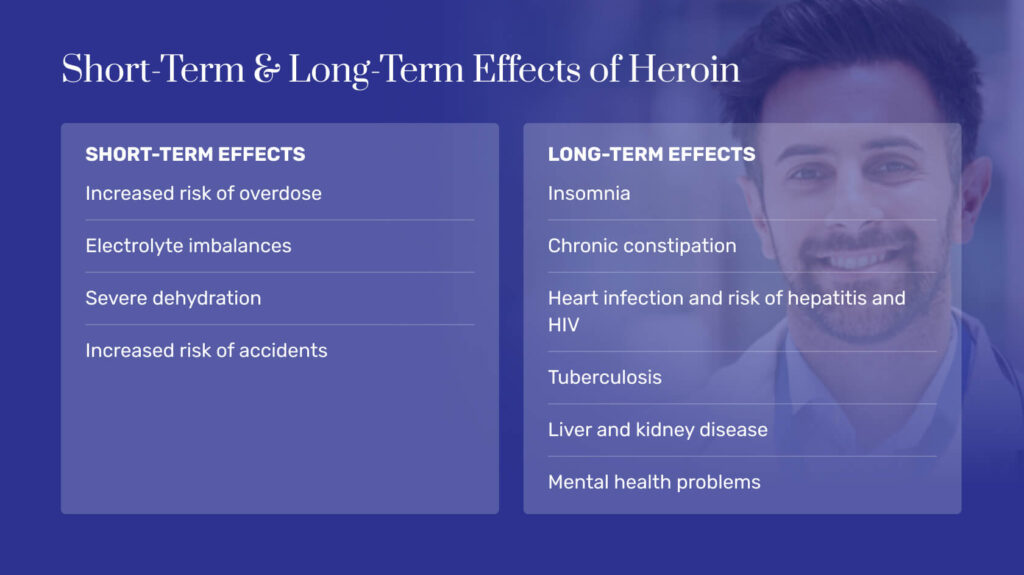About 1.1 million people in the United States reported past-year heroin use in 2021. And of those people, about 1 million had a heroin addiction.[1] Since heroin causes an intense euphoric rush and is metabolized out of the body just as fast, it is very easy to become addicted to this illicit opioid.
It’s important to know the symptoms and signs of heroin addiction so you can seek professional treatment for yourself or someone you care about. Quitting heroin on your own can be challenging but rehab, medication-assisted treatment, and therapy can help.
Symptoms vs. Signs of Heroin Use Disorder
| Heroin Addiction Symptoms | Signs of Heroin Addiction and Abuse |
|---|---|
| Strong cravings | Nausea and vomiting |
| Using large doses | Mental confusion |
| Failing to quit despite efforts to | Constipation |
| Spending a great deal of time obtaining and using heroin | Sexual dysfunction |
| Neglecting previously enjoyed hobbies | Insomnia |
| Physical, psychological, and social issues caused by use | Severe itching |
| Failing to meet obligations at home, school, or work | Track marks, collapsed veins, lesions, and scars |
| Experiencing tolerance and withdrawal | Nosebleeds, sinusitis, or nasal damage |
What Is Heroin?
Heroin is an illicit opioid drug derived from morphine. Dealers sell heroin in multiple forms, and it can be used through insufflation (snorting), ingestion, or injection. All forms of heroin, and all methods of using the drug, are incredibly dangerous and can lead to addiction. [2]
Common street names for heroin include:
- China white
- White lady
- Brown crystal
- Black pearl
- Joy powder
- Dope
Heroin users are often adept at using slang since they must buy the drug from dealers to use it.
Heroin is a Schedule I substance in the United States, meaning it has no legitimate medical use and is illegal to make, use, or sell.[2]
Common Forms of Heroin
Heroin is sold on the streets in many forms. The version someone buys often dictates how the drug is used.
Heroin is sold in the following forms:[2],[3]
- White powder: White powdery or chalk-like heroin that may be snorted, smoked, or injected. But heroin is never pure, and even white powder heroin is typically cut with sugars, starch, powdered milk, or deadly drugs like fentanyl or carfentanil.
- Brown powder: Less-processed forms of heroin take on a brown tinge from sap and impurities. This type of heroin is often snorted, smoked, or mixed with fluids and injected.
- Black tar: This type of heroin is black, sticky, and solid. Heroin users living west of the Mississippi often encounter this form of the drug. The color comes from crude processing methods that leave impurities behind. People tend to dissolve this version of heroin, mix it with fluid, and inject it.
What is Heroin Addiction?
Heroin addiction is a chronic medical and psychiatric condition characterized by compulsive heroin abuse regardless of negative consequences, such as failure to meet responsibilities, declining mental and physical health, job loss, and beyond. [4]
Like many conditions, it can range from mild to severe, depending on how many symptoms of heroin addiction a person exhibits. [4]
Signs and Symptoms of Heroin Addiction
The Diagnostic and Statistical Manual of Mental Disorders, Fifth Edition (DSM-5), outlines the criteria for heroin addiction or opioid use disorder. These symptoms include: [4]
- Using heroin in larger doses or for a longer period than intended
- Wanting to quit heroin but failing to control or stop use
- Spending an excessive amount of time obtaining and using heroin as well as recovering from its effects
- Experiencing strong cravings to use heroin
- Failing to fulfill obligations at home, school, or work due to heroin abuse
- Continuing to use heroin despite interpersonal or social problems caused by use
- Neglecting hobbies or important activities due to heroin use
- Using heroin in dangerous situations, such as while driving
- Continuing to use heroin despite psychological or medical issues caused or worsened by use
- Needing higher and higher doses to feel high (tolerance)
- Experiencing heroin withdrawal symptoms when abruptly stopping use
Someone has a mild heroin addiction if they exhibit 2-3 symptoms, moderate if they have 4-5 symptoms, and severe if 6 or more symptoms are present. [4]
Heroin Withdrawal Symptoms
Heroin withdrawal symptoms emerge when someone who is dependent on heroin abruptly stops using it or is unable to access it. These symptoms can be distressing and painful and may include:[1],[4]
- Muscle and bone pain
- Sleep disturbances
- Nausea, vomiting, and diarrhea
- Stomach cramping
- Restlessness and anxiety
- Depressed mood
- Cold flashes with goosebumps
- Fever
- Excessive sweating
- Uncontrollable leg movements
- Excessive yawning
- Dilated pupils
- Severe heroin cravings
If your loved one has a heroin addiction, you may notice that they shift between euphoric and relaxed highs and distressing withdrawal syndromes that resemble the flu.
If your loved one has a heroin addiction, you may notice that they shift between euphoric and relaxed highs and distressing withdrawal syndromes that resemble the flu.
Observable Signs of Heroin Abuse
In addition to symptoms, there are many observable signs of heroin abuse that you may notice in your loved one, such as: [1], [4]
- Erectile dysfunction
- Chronic constipation
- Irregular menses
- Small pupils
- Nausea and vomiting
- Severe itching
- Going “on the nod”
- Clouded mental functioning
- Insomnia
- Secretive behavior
- Withdrawing from family and friends
- Heroin paraphernalia, such as spoons, needles, cotton balls, string or shoelace, lighter, straw, aluminum foil, and pipes
Signs that they’re injecting heroin may include:[4]
- Track marks
- Collapsed veins
- Puncture marks
- Abscesses
- Cellulitis
- Circular scars from healed lesions
Signs that they’re snorting heroin may include:[4]
- Chronic nosebleeds
- Nasal damage
- Chronic sinusitis
- Perforated nasal septum
Why is Heroin So Addictive?
Heroin is a potent opioid that quickly binds to opioid receptors in the brain, leading to an intense rush of pleasure and euphoria as well as pain relief and relaxation. These effects come on rapidly and are very powerful; however, the effects of heroin are short-lived, causing a person to want to use it repeatedly to keep the high going.
Generally speaking, drugs with a rapid onset of intense effects that last for a short while are more addictive than long-acting drugs. The high tends to be more powerful and euphoric and can lead to a cycle of continued heroin abuse to avoid the come-down or withdrawal. Repeated use increases the risk of harmful side effects, heroin addiction, and overdose.
Tolerance and Dependence
The body also rapidly develops a tolerance to heroin, so soon after beginning a cycle of heroin abuse, the original dose will no longer suffice. You will feel like you need to take more of this opioid to achieve the prior effects or to avoid withdrawal symptoms or a crash. As tolerance develops, physiological dependence is also quick to develop, which means you need to keep using heroin to avoid withdrawal and to function optimally.
Both tolerance and dependence contribute to the development of heroin addiction.
What Causes Heroin Addiction?
There is no single cause of heroin addiction—rather, the development of heroin use disorder is influenced by many interacting biological, environmental, social, and psychological risk factors. And even if you have several risk factors for heroin addiction, it doesn’t mean that you will necessarily develop this condition. These are simply influences that increase the likelihood of using heroin and progressing to addiction.
Some causes and risk factors of heroin addiction include: [5], [6]
- Family history of substance abuse
- History of trauma
- Childhood sexual, emotional, or physical abuse
- Childhood neglect
- Parental substance misuse
- Poor parental monitoring
- Easy access to heroin and other substances
- Peer pressure
- Family rejection of sexuality or gender identity
- Mental health disorders, such as depression, anxiety, or ADHD
- Using a high dose of heroin for a prolonged period of time
- Prescription opioid misuse
- Antisocial behavior
- Misbehavior at school
- Novelty-seeking and disinhibition
Again, heroin use disorder is a complex condition without one cause or influence. Typically, many biopsychosocial factors interact to increase the chance someone may abuse heroin and develop an addiction.
Heroin use disorder is a complex condition without one cause or influence. Many biopsychosocial factors interact to increase the chance someone may abuse heroin and develop an addiction.

Harmful Effects of Heroin Addiction
People who abuse heroin or have a heroin addiction face severe physical and mental health risks.
Short-Term Risks
People who use heroin report a rush, or a sense of immediate pleasure. People may also experience the following negative side effects:[
- Increased risk of overdose (especially because of heroin being cut with fentanyl or carfentanil)
- Complications from opioid withdrawal, such as electrolyte imbalances and severe dehydration
- Increased risk of accidents
Overdosing on heroin can lead to hypoxia, or a reduced amount of oxygen reaching the brain, which can cause coma and brain damage. [2]
Long-Term Risks
Long-term heroin abuse can also lead to the following:[2],[4],[8]
- Insomnia
- Chronic constipation
- Scars or thick tissue buildup where the drug is injected into the veins
- Damage to the inside of the nose when it is snorted
- Heart infection from dirty needles
- Increased risk of suicide
- Risk of tetanus and bacterial infections
- Risk of hepatitis and HIV
- Tuberculosis
- Hormonal changes leading to sexual difficulty or changes in menstruation
- Lung and breathing problems
- Mental health problems like depression or anxiety
- Liver and kidney disease
- Impaired immune functioning
Since heroin is often cut with other substances, such as powdered milk, starch, sugar, or talcum powder, injecting heroin can cause clogged blood vessels, leading to brain, kidney, liver, or lung damage. [2]
Heroin Compared to Other Drugs
Heroin vs. Other Drugs
Heroin Addiction Treatment
Medical Detox
Often, the first step on the continuum of care for opioid use disorder is medical detox, which is a short-term intervention used to manage heroin withdrawal symptoms and improve comfort and safety. Medical detox usually occurs in a hospital setting or a free-standing detox center and involves:
- Opioid withdrawal medications, such as methadone or buprenorphine
- Supportive care, such as IV fluids
- Mental health counseling
- Nutritional therapy
- Medical care for physical conditions
- Case management and wrap-around services
Once you complete heroin detox, the detox team will help you transition into a comprehensive rehab program.
Rehab Settings
Heroin addiction treatment can occur in several settings, which range in intensiveness and frequency, including:
- Inpatient rehab: The most intensive setting, you live at the facility for the duration of treatment and receive 24/7 supervision and treatment.
- Partial hospitalization programs (PHPs): A step down from inpatient, you live at home and attend up to 30 hours of therapy per week in a hospital setting.
- Intensive outpatient programs (IOPs): Less intensive than a PHP, you live at home and attend treatment for between 9 and 20 hours per week.
- Standard outpatient treatment: The least intensive and most flexible treatment option, you live at home and attend a few hours of counseling per week.
Any of these settings can be combined with medication-assisted treatment (MAT), which is the gold standard of care for heroin addiction.
Medication-Assisted Treatment
MAT involves the use of opioid addiction treatment medications and behavioral therapy to treat opioid use disorder. MAT medications may include:[2],[7]
- Buprenorphine: This partial opioid agonist binds to opioid receptors, relieving withdrawal symptoms and cravings without causing a high.
- Methadone: This full opioid agonist binds to opioid receptors in the brain, reducing cravings and withdrawal symptoms without causing euphoria.
- Naltrexone: This opioid antagonist medication blocks the rewarding effects of heroin and other opioids to reduce the desire to relapse or use.
- Suboxone. Suboxone contains both buprenorphine and naloxone. This combination reduces withdrawal symptoms and cravings and also deters misuse.
Some people take OUD medications for a few months or years while in recovery while others may take medication indefinitely as long as it helps their heroin addiction recovery.
Preventing Relapse
Addiction is a chronic condition. People can and do gain control over their symptoms. But relapse risks are real, and people must develop strategies to cope with them.
The following steps can help people lower their relapse risks:
- Use your medications. If the doctor recommends MAT, keep taking the drugs as prescribed. Don’t skip doses or stop taking them until your doctor tells you to.
- Keep your appointments. Therapy is an important part of recovery for many people. Keep your therapy appointments and work through your concerns and risks with your doctor.
- Join support groups. Many people appreciate meeting others in recovery through support group meetings. Find a group you enjoy and join meetings when the urge to use starts.
- Stay away from triggers. Your therapist can help you identify the people, places, and things that make you crave drugs. Once you’ve identified them, stay away from them.
Frequently Asked Questions About Heroin
We’ve compiled some of the most common questions about heroin.
What does heroin look like?
Heroin can look like a white powder, a brown powder, or a sticky substance that looks a little like tar.
What does heroin smell like?
Heroin smell varies depending on the type you use. White powder can smell pungent or acidic. Black-tar versions often smell like vinegar.
What does heroin feel like?
People who use heroin often report a rush of good feelings, followed by profound sedation and the sense of drifting in and out of sleep.
How long does heroin stay in your system?
Heroin moves out of the body very quickly. Most people don’t feel the impact of the drug after an hour or two.
How long does heroin addiction treatment usually last?
Heroin addiction treatment programs should last a minimum of 90 days. Most people need much longer treatment times to get better. Longer treatment teams are linked with better chances of sustained recovery.
Is heroin a stimulant or a depressant?
Heroin is a depressant. The drug slows breathing and heart rates, putting users into a relaxed and dream-like state.
Should you quit heroin cold turkey?
It’s not wise to quit heroin cold turkey. Physical and mental health symptoms can lead to relapse. Medical supervision and the use of medication-assisted treatment are recommended.
What percentage of heroin addicts recover?
It’s hard to know how many people truly recover from opioid addiction. Experts say about half of people relapse, but sometimes, they relapse once and never do so again.
- What is the scope of heroin use in the United States? (June 2018). National Institute on Drug Abuse.
- Heroin DrugFacts. (December 2022). National Institute on Drug Abuse.
- What Is Heroin and How Is It Used? (June 2018). National Institute on Drug Abuse.
- Diagnostic and statistical manual of mental disorders (5th ed.). American Psychiatric Association. (2013).
- High-Risk Substance Use Among Youths. (September 2022). Centers for Disease Control and Prevention.
- Identifying Early Risk Factors for Addiction Later in Life: A Review of Prospective Longitudinal Studies. Morales, A. M., Jones, S. A., Kliamovich, D., Harman, G., & Nagel, B. J. (2020). Current addiction reports, 7(1), 89–98.
- Opioid Addiction. (January 2023). StatPearls.
- What Are the Long-Term Effects of Heroin? (June 2018). National Institute on Drug Abuse.
- Predicting Long-Term Stable Recovery from Heroin Addiction: Findings From a 33-Year Follow-Up Study. (2007). Journal of Addictive Diseases.




